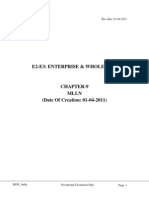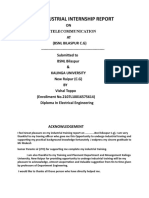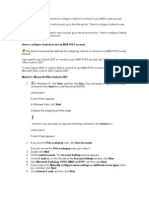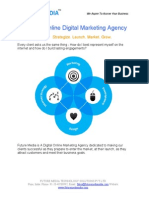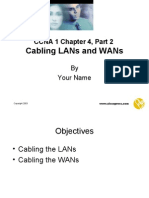Signal Telecom 2
Uploaded by
Jeetu SinghSignal Telecom 2
Uploaded by
Jeetu SinghSignal and Telecom
Signalling:
Advanced signalling systems such as complete Track Circuiting,
Multiple Aspect Colour Light Signalling, Panel/Route Relay/Electronic
Interlocking, Automatic Block Signalling, Block Proving by Axle Counter
are deployed on IR to improve level of efficient and safe train control,
optimum utilization of line capacity, etc. Interlocking of level crossings
and provision of telephones at manned level crossings have contributed
to enhancement of safety.
Comparative position of each item of signalling system as on March
31, 2007 vis-a-vis previous year is as follows:
(in units)
Installation As on 31.3.2006 As on 31.3.2007
Tokenless Block Working
(No. of Block Sections) 1,860 1,915
Automatic Block Signalling
(Track kms.) 3,265 3,457
Multiple Aspect Colour Light
Signalling (No. of stations) 4,203 4,446
Panel Interlocking (No. of stations) 2,911 3,262
Solid State Interlocking (No. of stations) 100 159
Route Relay Interlocking (No. of stations) 219 220
Safety devices at level crossings:
(a) Interlocking at level crossings - Nos. 7,781 8,064
(b) Telephones at manned level crossings
- Nos. 15,650 16,073
(c) Lifting barriers at level crossings - Nos. 8,292 8,490
Track Circuiting:
(a) Fouling Mark to Fouling Mark on run
through lines (No. of stations) 4,776 4,926
(b) Fouling Mark to Fouling Mark on
loop lines (No. of stations) 3,395 3,746
(c) Fouling Mark to Block Section Limit
(No. of stations) 3,964 4,144
Block Proving by Axle Counter
(No. of Block Sections) 632 908
Second Distant Signal (No. of stations) 1,185 1,110
Telecommunication:
Telecommunication plays an important role in control, operation
and safety. Following are the highlights of telecommunication systems
of IR.
Nationwide Broadband Optic Fibre Cable (OFC) Telecom Network:
With the change in telecommunication technology, IR has decided
Railway personnel engaged in signal to go for a state-of-the-art, nationwide telecom network for meeting its
maintenance work. communication needs and earning revenue by exploiting surplus
30 INDIAN RAILWAYS ANNUAL REPORT AND ACCOUNTS 2006-07
capacity commercially. With this objective in mind, RailTel, a Public
Sector Undertaking, was formed in September, 2000.
Of the 42,000 route kms. of Optic Fibre Cable (OFC) network that
has been planned for commissioning by 2008, more than 28,100
route kms. of OFC has been laid already. OFC connectivity between
four Metros and four mini Metros has been established and 203 other
important cities have also been connected. So far 2,717 stations have
been connected over the OFC network. RailTel has upgraded their
network by providing the latest state-of-the-art Multi Protocol Level
Switching (MPLS) network. Apart from modernizing the IR’s telecom
network, RailTel has started earning revenue by marketing surplus
bandwidth and other infrastructure to other service providers like AirTel,
Vodafone, Tata, BSNL and financial entities like State Bank of India,
etc.
Railways have also planned to provide 82 Cyber Cafes in the first
phase of which 24 railway stations have already been provided with
Cyber Cafes. Apart from this, 50 stations will also be provided with
Wi-Fi/Wi-Max facility.
Mobile Train Radio Communication (MTRC):
Global Service Mobile (GSM) based MTRC system is being
introduced on ‘A’, ‘B’ & ‘C’ routes of IR for communication between
train crew and stationary operating staff such as Station Masters,
Controllers, field maintenance staff, etc. Works for over 3,200 route
kms. have been sanctioned on Northern, North Central, Eastern, East
Central and Northeast Frontier Railways. Works on Eastern and
Northeast Frontier Railways have been completed and are under trials.
Balance works are expected to be commissioned in 2008-09.
Railway’s V-SAT Hub:
IR is planning to commission its own V-SAT hub at New Delhi to
facilitate connectivity from the remote FOIS locations using V-SAT
terminals. Presently, about 200 remote sites are planned for connectivity.
V-SAT system has the potential to meet voice and data communication
requirements of remote locations that are lacking in telecom
infrastructure.
Switching and Data Networks:
Railways are replacing old analogue exchanges with digital electronic
exchanges to improve quality of switching and to reduce the
maintenance efforts. During the year, a total of 8,922 subscribers were
connected to digital electronic exchanges bringing the total subscribers
to 2,94,214.
All Zonal and Divisional exchanges of IR are being integrated for
seamless connectivity with uniform STD scheme for improved services
by providing 2 MB connectivity. Broadband connectivity of 2 Mega
INDIAN RAILWAYS ANNUAL REPORT AND ACCOUNTS 2006-07 31
Byte Per Second (MBPS) or more is being increasingly provided
between Divisional and Zonal headquarters to establish high speed link
needed for various IT applications like Railnet, PRIME, AFRES, MIS,
etc. To improve reliability and to effect savings, data circuits required
for on-line applications like PRS, UTS and FOIS are being progressively
transferred to Railway’s own OFC network.
Passenger Amenities:
With a view to provide improved passenger amenities, Train
Indication Boards at 1,055 stations, Public Address System at 3,081
stations and Coach Guidance Boards at 141 stations have been installed.
In addition, Interactive Voice Response System (IVRS) has also been
provided on 509 locations. Integrated Train Enquiry System with unique
No.139 was also commissioned during the year to provide information
to the travelling public in respect of all train movement and reservation
related queries.
The progress of installation of telecom equipment on IR is given
below:
(in units)
Installation As on 31.3.2006 As on 31.3.2007
Digital Electronic Exchanges
(No. of Lines) 2,85,292 2,94,214
No. of Control Sections provided with
Dual Tone Multiple Frequency (DTMF)
control equipment 295 295
Digital Microwave (7 GHz)
(Route kms.) 7,093 7,093
Control communication through
wireless (18 GHz) (Route kms.) 989 989
Mobile Train Radio Communication
System (Route kms.) 1,686 1,686
OFC Communication System for Control
Communication (Route kms.) 25,269 28,124
Public Address System (No. of stations) 2,708 3,081
Train Display Boards (No. of stations) 925 1,055
Interactive Voice Response System (IVRS) 457 509
(No. of stations)
Coach Guidance System (No. of stations) 129 141
32 INDIAN RAILWAYS ANNUAL REPORT AND ACCOUNTS 2006-07
You might also like
- Role of The Signalling & Telecommunications Department: Signal & TelecomNo ratings yetRole of The Signalling & Telecommunications Department: Signal & Telecom10 pages
- Mobile Train Radio Communication PPT SlideshareNo ratings yetMobile Train Radio Communication PPT Slideshare28 pages
- A Training Report On BSNL Ocb 283 Exchange100% (1)A Training Report On BSNL Ocb 283 Exchange47 pages
- Chapter 1 - Axle Counter System - IntroductionNo ratings yetChapter 1 - Axle Counter System - Introduction9 pages
- Indian Railway Training For B Tech UPTU GBTU MTU RGPVNo ratings yetIndian Railway Training For B Tech UPTU GBTU MTU RGPV44 pages
- Equalization On-Channel Repeater For Terrestrial Digital Multimedia Broadcasting SystemNo ratings yetEqualization On-Channel Repeater For Terrestrial Digital Multimedia Broadcasting System9 pages
- Data Communication Sample Tutorial& AnswerNo ratings yetData Communication Sample Tutorial& Answer14 pages
- Solid State Block Proving by Axle Counter (Digital) : Vinay Polepalli, M Anil KumarNo ratings yetSolid State Block Proving by Axle Counter (Digital) : Vinay Polepalli, M Anil Kumar10 pages
- Optical Transport Networks Training OTN TrainingNo ratings yetOptical Transport Networks Training OTN Training8 pages
- Indian Railway Training For B.Tech (UPTU/GBTU/MTU/RGPV)50% (4)Indian Railway Training For B.Tech (UPTU/GBTU/MTU/RGPV)42 pages
- Train Detection, The Basics by Paul Darlington and David Fenner - Back To Basics PDFNo ratings yetTrain Detection, The Basics by Paul Darlington and David Fenner - Back To Basics PDF8 pages
- Wireless Measurement System For CDMA Base Station Transmit PowerNo ratings yetWireless Measurement System For CDMA Base Station Transmit Power4 pages
- Advancement and Use of Metro Ethernet ServicesNo ratings yetAdvancement and Use of Metro Ethernet Services33 pages
- Industrial Training: Hutchison Essar South Ltd. (Punjab)No ratings yetIndustrial Training: Hutchison Essar South Ltd. (Punjab)34 pages
- Analysis of Iterative Decoding For Turbo Codes Using Maximum A Posteriori AlgorithmNo ratings yetAnalysis of Iterative Decoding For Turbo Codes Using Maximum A Posteriori Algorithm100 pages
- Singalling and Telecommunication in Indian Railway: Presented By: Ankita Jangid 7 Sem Ece 09ESOEC012No ratings yetSingalling and Telecommunication in Indian Railway: Presented By: Ankita Jangid 7 Sem Ece 09ESOEC01225 pages
- Digital Transmission Technology An OverviewNo ratings yetDigital Transmission Technology An Overview43 pages
- Back To The Top: How To Configure Outlook To Use An MSN POP3 AccountNo ratings yetBack To The Top: How To Configure Outlook To Use An MSN POP3 Account5 pages
- 8086 Microprocessor Programming & Instruction Sets:: Immediate AddressingNo ratings yet8086 Microprocessor Programming & Instruction Sets:: Immediate Addressing8 pages
- 5CS4-04 Computer Graphics & Multimedia Set 1No ratings yet5CS4-04 Computer Graphics & Multimedia Set 11 page
- السحر الاحمر والكبريت الافخر للحسينى الفلكى مطبوع واضح PDF PDF Cooking, Food & Wine Self-ImprovementNo ratings yetالسحر الاحمر والكبريت الافخر للحسينى الفلكى مطبوع واضح PDF PDF Cooking, Food & Wine Self-Improvement1 page
- Online Digital Marketing Agency India - Future MediaNo ratings yetOnline Digital Marketing Agency India - Future Media5 pages
- Cabling Lans and Wans: Ccna 1 Chapter 4, Part 2No ratings yetCabling Lans and Wans: Ccna 1 Chapter 4, Part 235 pages
- Embedded Systems Design Using Arm TechnologyNo ratings yetEmbedded Systems Design Using Arm Technology3 pages
- Department of Education Caraga Region Division of Agusan Del Sur Prosperidad National High School Purok-22, Poblacion, Prosperidad, Agusan Del SurNo ratings yetDepartment of Education Caraga Region Division of Agusan Del Sur Prosperidad National High School Purok-22, Poblacion, Prosperidad, Agusan Del Sur4 pages
- Practical 11 Router Configuration: February 2013No ratings yetPractical 11 Router Configuration: February 20135 pages
- Ibm Powerha 6.1 On Aix 6.1 Demonstration: Resource Group DetailsNo ratings yetIbm Powerha 6.1 On Aix 6.1 Demonstration: Resource Group Details6 pages
- 3GPP TS 36.331: Technical SpecificationNo ratings yet3GPP TS 36.331: Technical Specification769 pages
- Acer Aspire 5330 - 5730 Wistron Cathedral Peak RevSBNo ratings yetAcer Aspire 5330 - 5730 Wistron Cathedral Peak RevSB42 pages



















